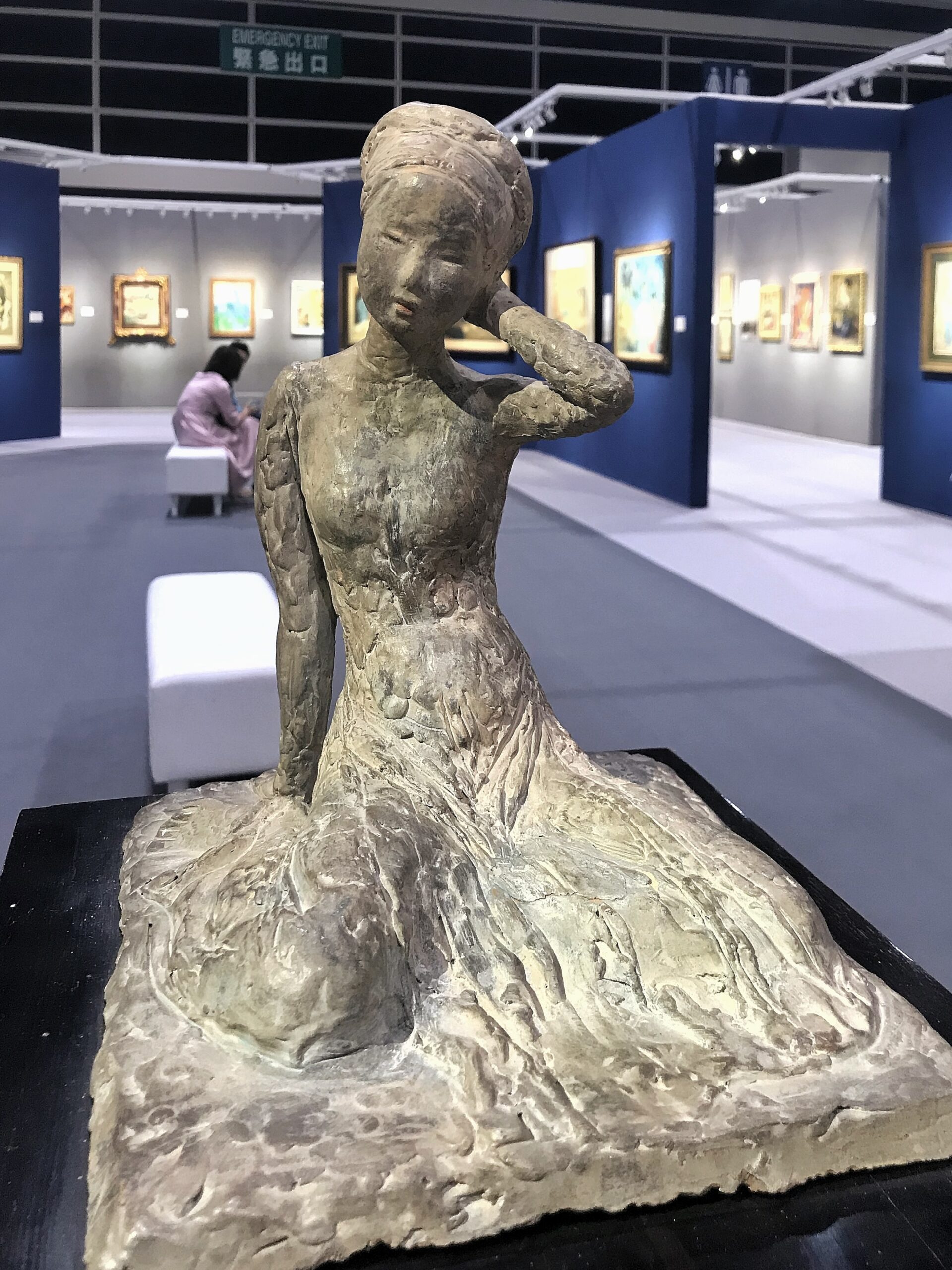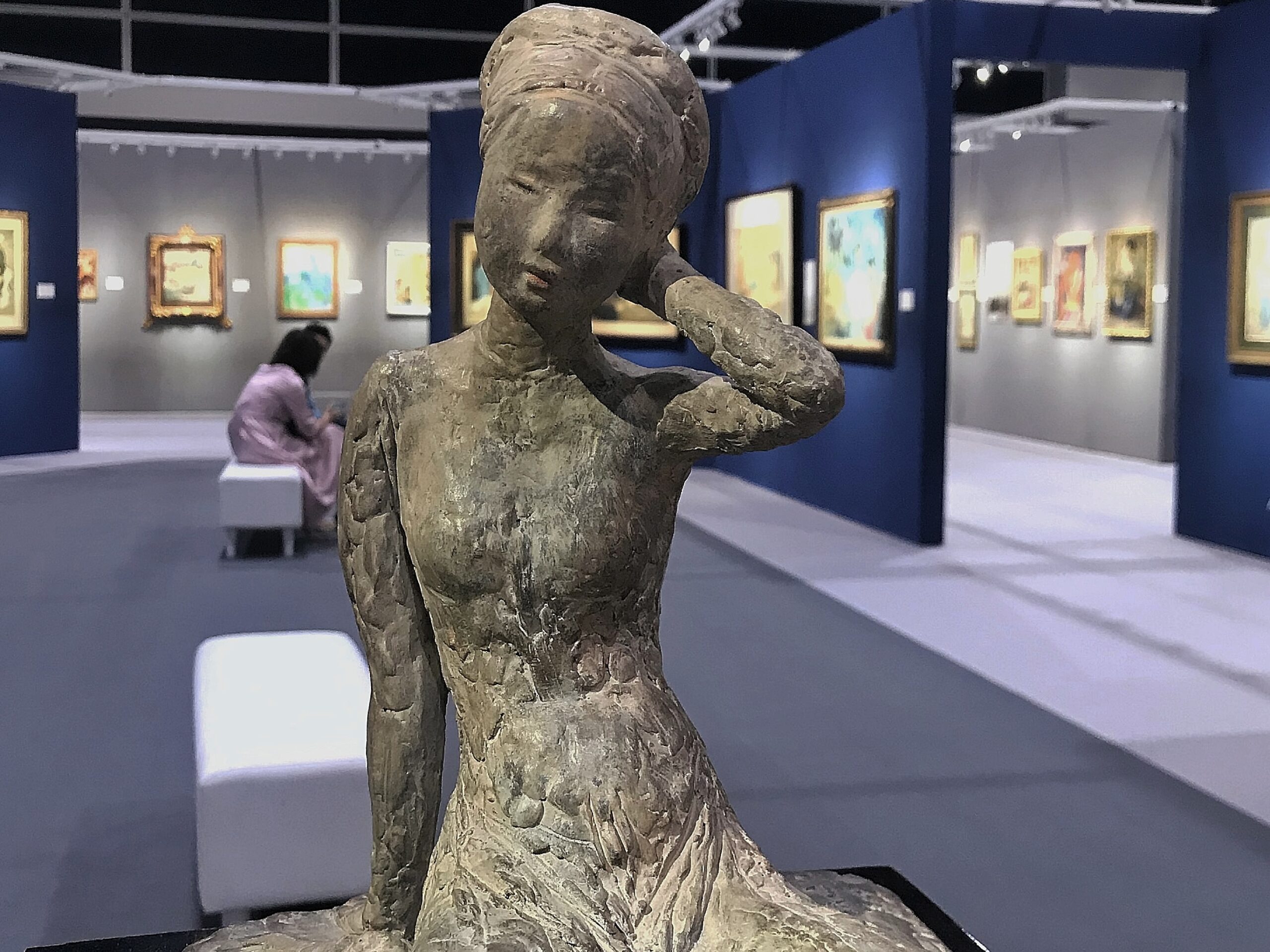
Vu Cao Dam (1908-2000)
Femme Agenouillée (Kneeling Woman)
inscribed 'terre cuite, pièce unique' and signed 'vu cao dam' (on the base)
terracotta sculpture
29.5 (H) x 28.5 x 31.5 cm. (11 5/8 x 11 1/4 x 12 3/8 in.) (with pedestal)
Executed circa. 1940-1945
unique edition
Provenance
Anon. Sale, Sotheby's Singapore, 4 April 2004, lot 74
Acquired from the above sale by the present owner
Collection of Mr Tuan H Pham, California, USA
Christie's Hong Kong, 26 May 2019

Vu Cao Dam's Femme Agenouillée (Kneeling Woman) at Christie’s Hong Kong: The Tuan Pham Collection, 26 May 2019
"But me, my face is a flower and my eyebrows are as gracious as the flowers of a willow. My beauty has the same brightness then the half moon."
Lê Qui Dôn (1726-1784)
Mother, I want to Marry
Very early on, Vu Cao Dam developed an extraordinary talent as a sculptor while at the Hanoi Fine Arts School. He was only in his fifth year in the School when Victor Tardieu selected 6 sculptures to be presented in the Paris Colonial Exhibition in 1931. Five of them were in bronze and only one was made of plaster. The same year, he arrived in France, the artist successfully pursued his sculptured work along with his visual work.
During the Second World War, it became very difficult to obtain the raw materials to make bronze sculptures in German-occupied France. So Vu Cao Dam used clay to create unique terracotta artworks in this period, between 1940 and 1945. At the end of the war he exhibited his exquisite and powerful sculptures at L'Art Français gallery in Paris.
Our sculpture presented here is executed by hand without using a mold, a fact reminded here by the artist when in his writings he mentions "terre cuite, pièce unique" (terracotta, single piece).
The sculptor captured in a wonderful and evocative way the grace, dignity and abandonment in this beautiful Tonkinese young lady kneeling, the clear neck: the straight right arm supporting fictitiously a face simulating abandonment; the evocation of her ao dai and her soft and sensual face. This is the work of the artist at his best.
By the mastery in the modelling and the incision, this sculpture can truly be considered a masterpiece.
The Tuan Pham Collection
Elegance Of The Heart And Vietnamese Masterworks
A man with a quiet smile despite heavy odds is most likely a survivor. And the collector Tuan Pham has a quiet smile that's both peaceful and subtle.
From the outset, we understand that from a long time since, he knows that words are the scars of the soul: a sense of self-restraint in his expression, choosing to hold back a little. Let's hope he will forgive us for getting him to say a few words on himself and his splendid collection, our best ally in our intrusive quest in Vietnamese fine art.
An extraordinary collection started 30 years ago:
“…during one of my leisure vacations in South Florida in the late 1990s, I was walking by a small gallery and caught a glimpse of a small painting. It was a still life composition with vase and flowers. The vase was blue and white, reminiscing of the 19th century vase exported from China. The flower was beautiful yellow and blue, and in the obscured background was the Eiffel Tower. There was a story within the painting to be discovered. As I approached the painting, I saw that it was signed in Chinese characters above the name Le Pho (which I thought was Li Pho, a Chinese name). I purchased the painting without realizing that Le Pho was an artist from Vietnam. It was the first painting in my Vietnamese collection, and it started a personal journey that reconnects me with my birthplace.”
Taking a prophetic meaning, this first purchase resembles more a manifesto in that it condenses yet encompasses all the elements that give the 20th Century Vietnamese paintings its true universal value. Vietnam, where the painter Le Pho was born in Hadong near Hanoi), France (the Eiffel Tower), China (the vase), America (South Florida), all clues that define the Vietnamese pictorial approach.
But a first stone is not enough to build a castle. Other explanations are perhaps needed to better understand Tuan Pham's pioneer's work. Any successful life consists in consoling the child we once were. It seems to particularly ring true of that for our collector.
Saigon, April 1975 - a child of thirteen years is with his brother and both are waiting to leave and flee their country. The war rumbles in the city's faubourg, a war the young man barely felt until then, as he was brought up in Dalat in an affluent family. The young Tuan then finds himself in Florida as a refugee, labelled an orphan before getting to California alone with his brother as his whole family (father, mother, and siblings) stayed in Vietnam. He will see them again only 18 years later.
Overcoming, excelling, surpassing: for Tuan Pham there were no other choices. At a young age he knew already that a quiet stoicism was needed, and that noise and complaint does not do much good. Overcoming the difficulties of the moment, concentration on self, neglecting the derisory: such was the way 'combat' was engaged and won.
Was he inspired by Nguyen Binh Khiem (1491-1585):
" In my madness I searched solitude
The clever ones can mingle in the noise of the world " ?
(Time Table)
In 1978, he met the one who would become the love and the strength of his life, Jacqueline Diem Thuy Tran. This and becoming a brilliant PhD graduate in 1989 (University of California, San Diego), would become his first milestones in what would be a path of hard work which led to continued success:
"I started Phamatech, a biotechnology company and laboratory, in 1992. My mission is to utilize new and emerging technologies to provide greater health awareness, early diagnosis of medical conditions and enhance quality of life and treatment options for patients. Now more than 25 years later, not only was I able to achieve my professional goal in building a respectable and meaningful company, I have been able to share Phamatech's success by giving back to the community. For many years, Phamatech has been a regular sponsor for numerous community events to promote different culture and arts, especially Vietnamese. We help started a non-profit group that teaches Vietnamese language and culture, and for each of the past 10 years, Phamatech has given out college scholarships to many under-privileged students to achieve their dream of attending college.”
The first part of the collection presented here includes seventeen works and nine painters. Four of these painters would leave Vietnam for a life in France where they will create, live and die. Five others would stay in Vietnam. If it appears like an equitable number between those who left and those who stayed, it is important to mention that the four are represented by twelve works and the five by five works... What really brings to attention in the collection are thematic representations: the over representation of woman, a mother (his mother, the mother of his three sons, Alan, Brian and Daniel); being in love; sisterhood; elegance and grace ; emancipation and freedom; and objects of desire or contemplation.
The expression of a strict classical Vietnam is also very present by the depictions of women in the traditional ao dai, conical hats, traditional buildings; traditional games; traditional fishing, and the civil mandarin. It is important to note that the divine is barely evoked and that the themes can intersect: in To Ngoc Van's masterpiece Les Désabusées for example where the elegance of the pose doesn't obliterate the power of the message (and its quest for meaning). Vu Cao Dam's Amoureux (Lovers) is also an allusion to the Kim Vân Kiêu.
There are no landscape paintings either as if the paintings were a mirror in which the collector could gaze at past times.
The following works featured here are masterpieces, executed by painters at the height and best of their art. To complement the works, we have added poems extracts to enhance and explain the works as a tribute to Tuan Pham, a lover of art and poetry. As a collector of such beautiful paintings on this journey here, we step aside and let him say the last few words here.
“I have grown attached to many paintings, but like the artist who painted it, it really isn't my painting, and it should continue to find its place among collectors. My journey is complete, and it's time for someone else to start his or her own personal journey.”
Jean-François Hubert
Senior Expert, Vietnamese Art










